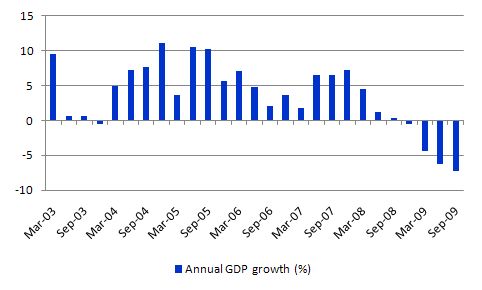
Networked ECONOMY
Before the 2008 economic crisis Iceland had a high growth economy including one of the world’s lowest unemployment rates and most evenly distributed income to population ratios. Iceland has always been an advocate in Information Communication Technologies (ICT) with one the world’s highest Internet user rankings and ties the United States in computer to population ratio 1:1000. In 1995 Iceland was the first nation to have a completely digital phone network that covered the entire country. However, due to the global economic crisis, Iceland’s growth has been greatly affected. In 2009 Iceland reported a growth of -6.5% and some financial analysts believe Iceland is headed in the direction of an economic depression. Iceland's unemployment rate is rising well above 12% with only a population of 320,000 and the GDP dropping to historical lows.

ICT Employment Opportunities: (Stage 4)
Until recently, Iceland’s economy has been heavily dependent upon industries such as fishing, aluminum, and ferrosilicon. Recently Iceland has diversified its economy and is expanding in areas related to geothermal/hydropower, software development, IT Infrastructure, biotechnology, and tourism. A large percentage of companies in Iceland require an IT department in which also requires IT staffing. Large IT companies such as IBM, HP, Microsoft, Computer Associates, and many others now operate in Iceland which in turn increases the demand for ICT employment. Iceland was also recently named the ideal location for datacenter buildings. Large companies are now considering Iceland to handle a large portion of their datacenter operations. This shift is directly related to cheap and energy efficient operating environments. Iceland’s electricity is mostly produced via geothermal and hydropower plants which allows consumers to pay as little as four cents per kilowatt-hour compared to eleven cents in the United States. Companies looking to take advantage of these cheap prices are able to get contracts for 20 year fixed rates. This, along with Iceland’s naturally cool climate has begun attracting a number of customers looking to save money.

Business-to-Consumer Electronic Commerce (Stage 3)
Although Iceland has one of the world’s highest Internet connectivity ratings, it still only ranks average in the area of B2c. Around only 30% of Iceland’s businesses receive Internet orders while almost 70% of businesses purchase supplies via the Internet. This could be largely due to the majority of the population lively in a single dense area. There is less need to make online purchases from local businesses when people can simply visit the location or phone in an order and easily pick it up. When considering B2c in Iceland we must remember that the majority of its goods especially electronics are imported. This drastically reduces domestic B2c e-commerce but on the other hand greatly increases B2c with other countries. However, Internet banking in Iceland is ranked the highest in Europe with more than 68% of the population banking online.
Business-to-Business Electronic Commerce (Stage 4)
Iceland exports more than 40% of its industry’s products, while its businesses purchase more than 70% of their products via the Internet. Some 50% of businesses have integrated internal IT processes but only 20% integrate with external businesses processes. Banking was one of Iceland’s most successful markets before the economic crisis in 2008. The Icelandic banks were some of the most advanced in Europe and expanded many of their branches to other countries via the Internet. This promoted investments from other companies, universities, citizens, organizations and governments from around the world. British universities such as Cambridge had roughly 20 million in savings and the British police force had more than 180 million invested in these banks via online banking. When the economic crisis hit, these assets were frozen as the banks scrambled to honor their debts. The country simply had too few reserves to cover the withdrawals.
E-Government (Stage 3)
In recent years, Iceland’s government has made an effort to offer an abundance of services online to its people and businesses. Although they rank fairly well in Europe, Iceland falls behind when compared to larger governments like the United States. Roughly 41% of basic public services for citizens are fully available online, while nearly 70% of public services for businesses are available online. However, the population appears eager to take advantage of theses online services with 70% of the population and 94% of businesses using the available e-Government services. In recent years there has been a high demand for e-Government services to be made readily available to the population. Iceland is still determined to meet these needs given the current economic crisis.